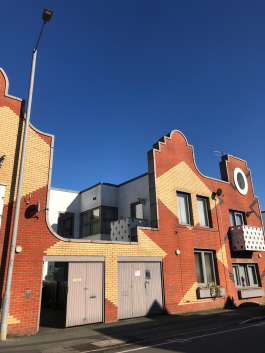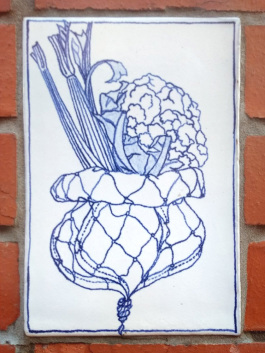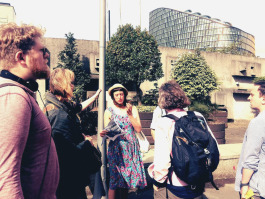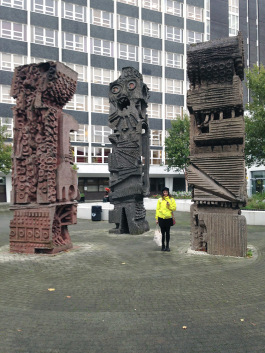I have been commissioned to deliver tours for organisations including Manchester Metropolitan University, Manchester School of Architecture and the Centre for Chinese Contemporary Art. These have explored aspects of the city’s history and development through its urban fabric and public art.

This tour, for undergraduate and Masters level architecture students, looked at the history and development of two urban areas of Manchester, both in the M4 postcode, through their housing and built environment.
Exploring concepts around heritage, identity and gentrification, it asked which groups and activities are no longer accommodated as the city increasingly promotes inner-city living. The tour began at a row of partially demolished weavers’ cottages, dating back to the late-18th-century, in the area now known as the Northern Quarter. Representing a rare surviving example of early workers’ housing in the city, they exemplify current debates about the future and heritage of the area. Despite being listed in recent years, their future is in doubt due to a proposed development of luxury flats on the site (a development has been subject to a public and protracted planning battle).
The tour then visited the redbrick 1970s Smithfield Gardens Estate, an early and rare example of low-rise 20th-century social housing built in the city centre in an area adjacent to the former Smithfield Market buildings. This was used as a starting point to explore the ways in which the area has changed from a place dominated by trade to a residential and entertainment district known for its creativity and culture.
The tour then crossed the inner ring road into the former industrial suburb of Ancoats, in order to highlight the northwards expansion of the city centre over the past decade. It considered the ways in which the use of buildings, and mix of residents, has changed over time, as former mill buildings have been converted from industrial to a mix of other uses, from nightclubs to offices to residential.
Although some of the city’s earliest social housing is still standing and in use in the locale, the fate of other estates has been more problematic and contested. The tour considered how the make-up of the area has fundamentally changed with the advent of ‘New Islington’, masterplanned by Will Alsop on the site of the former Card Room estate, and now encompassing a mixture of affordable and private housing as well as a school, park and new canal arm. The tour explored the role of the canals and the eastern expansion of the Metrolink network in changing perceptions of Ancoats and New Islington as places to live, as well as controversies over foreign investment and financing.
It also considered what is lacking, with reference to high-profile campaigns around heritage assets and access to green space. It concluded by considering a recent mill conversion, previously housing a longstanding artists’ studio group as well as small-scale textile businesses, to ask questions about which groups are no longer able to find space, homes and a sense of belonging in the city.

I was asked to devise a creative exploration of Manchesters’s Northern Quarter for English undergraduates on the ‘Manchester and the City’ module at Manchester Metropolitan University. This module required students to undertake a research project on ‘Manchester as text’ and produce an artefact related to the city.
My tour highlighted some of the permanent and temporary artworks installed in the Northern Quarter. It explored their various forms and functions, from adding decorative and visual appeal to the streets, and creating a sense of place, to celebrating and commemorating the history of the area, and showed how they have contributed to the distinctive identity and atmosphere of the Northern Quarter.
These public commissions date primarily from the 1990s onwards, when this part of the city began to be transformed from a run-down former textile, wholesale and retail district to a place known for its creative identity, independent businesses and night life.
My tour considered the ways in which the area continues to change and evolve, and the extent to which its different uses coexist. It addressed current debates about ongoing and future developments in the area, and how they might impact the character and qualities for which the Northern Quarter has become known and valued by those who live, work and socialise there.

I was asked to develop a street art tour to celebrate 30 years since the Centre for Chinese Contemporary Art (formerly known as the Chinese Arts Centre) was established, and to coincide with an exhibition featuring artists from RareKind China illustration agency.
My tour took as its basis an expanded definition of street art, encompassing not just what we might usually regard as street art, ie that which is covert, transient and wall-based, but situating street art within a wider context of all art which is publicly visible on the streets of Manchester, from mosaics and architectural adornment to statues and sculptures.
Street art is something which we have all seen, and about which most of us have an opinion. The tour aimed to be informal, accessible, flexible and participatory, with participants invited to share, reflect on and challenge their own perceptions and experiences of street art and to disclose any particular favourites in the area. I invited discussion on questions such as: Who gets to decide what is art, and who is an artist? How do works of art on the street influence perceptions of a place, both by the people who live / work there and externally? What is ‘beauty’, and who decides what’s beautiful? Does art need to be beautiful? Can a value be placed on street art?
My tour visited two distinct areas of Manchester city centre – Chinatown and the Northern Quarter – as part of a broader narrative of change and evolution. Manchester has transformed from an industrial Victorian city to a modern city known for its entertainment, creativity and leisure / shopping opportunities, and this can be read through the art on its streets (or lack of it in certain places). Street art may have different motivations, from self-expression and ownership of spaces to decoration, celebration and commemoration of heritage, but all contribute to the identity, atmosphere and demographic of different areas and show how people have shaped Manchester over time.
My tour also offered contrasts and comparisons between: public art which is official and council-endorsed, and commissioned from high-profile artists; gallery-supported initiatives; local businesses promoting local artists; corporate sponsorship of street art, and street art techniques which have been co-opted for advertising purposes; and street art which is unsolicited and illegal.

I created a tour for a group of human geography undergraduates from the University of Central Lancashire, which I subsequently turned into a publication. My tour aimed to offer a brief introduction to the historical context and development of public art, and some of the debates, concerns and issues surrounding it. I posed questions such as ‘What is public art?’ and ‘What form does it take?’.
My tour took as its starting point the post-war era, widely regarded a time when artworks began to step down from the gallery plinth to be installed in public places and buildings. Many of these artworks, however, used the same form and materials as artworks which might be seen in a traditional institutional setting. They also often relied on the same assumed distance between artwork and viewer, and fitted into the same framework of interpretation.
I concluded the tour in the present-day. My accompanying publication moves from object-based artworks to highlighting artworks which are ephemeral, activity and performance-based. These may leave the viewer with little or nothing to look at on a permanent basis, but nonetheless contain the potential to transform the way their participants think about and experience the city, and interact with certain spaces and situations. My guide discusses artworks which aim to engage with communities and local people, as well as artworks linked with specific places and pieces linked with wider agendas of tourism and regeneration.
My publication also acts as an introduction to an area of Salford which has undergone several phases of development, decline and renewal and is currently undergoing transformation and attempted gentrification at an accelerated pace. It starts at the University of Salford, progressing down the Crescent and Chapel Street. My guide draws on a number of sources, including original interviews undertaken with artists, curators and others involved in public art in the area and published elsewhere, including on The Shrieking Violet blog.
I have been commissioned to deliver tours for organisations including Manchester Metropolitan University, Manchester School of Architecture and the Centre for Chinese Contemporary Art. These have explored aspects of the city’s history and development through its urban fabric and public art.

This tour, for undergraduate and Masters level architecture students, looked at the history and development of two urban areas of Manchester, both in the M4 postcode, through their housing and built environment.
Exploring concepts around heritage, identity and gentrification, it asked which groups and activities are no longer accommodated as the city increasingly promotes inner-city living. The tour began at a row of partially demolished weavers’ cottages, dating back to the late-18th-century, in the area now known as the Northern Quarter. Representing a rare surviving example of early workers’ housing in the city, they exemplify current debates about the future and heritage of the area. Despite being listed in recent years, their future is in doubt due to a proposed development of luxury flats on the site (a development has been subject to a public and protracted planning battle).
The tour then visited the redbrick 1970s Smithfield Gardens Estate, an early and rare example of low-rise 20th-century social housing built in the city centre in an area adjacent to the former Smithfield Market buildings. This was used as a starting point to explore the ways in which the area has changed from a place dominated by trade to a residential and entertainment district known for its creativity and culture.
The tour then crossed the inner ring road into the former industrial suburb of Ancoats, in order to highlight the northwards expansion of the city centre over the past decade. It considered the ways in which the use of buildings, and mix of residents, has changed over time, as former mill buildings have been converted from industrial to a mix of other uses, from nightclubs to offices to residential.
Although some of the city’s earliest social housing is still standing and in use in the locale, the fate of other estates has been more problematic and contested. The tour considered how the make-up of the area has fundamentally changed with the advent of ‘New Islington’, masterplanned by Will Alsop on the site of the former Card Room estate, and now encompassing a mixture of affordable and private housing as well as a school, park and new canal arm. The tour explored the role of the canals and the eastern expansion of the Metrolink network in changing perceptions of Ancoats and New Islington as places to live, as well as controversies over foreign investment and financing.
It also considered what is lacking, with reference to high-profile campaigns around heritage assets and access to green space. It concluded by considering a recent mill conversion, previously housing a longstanding artists’ studio group as well as small-scale textile businesses, to ask questions about which groups are no longer able to find space, homes and a sense of belonging in the city.

I was asked to devise a creative exploration of Manchesters’s Northern Quarter for English undergraduates on the ‘Manchester and the City’ module at Manchester Metropolitan University. This module required students to undertake a research project on ‘Manchester as text’ and produce an artefact related to the city.
My tour highlighted some of the permanent and temporary artworks installed in the Northern Quarter. It explored their various forms and functions, from adding decorative and visual appeal to the streets, and creating a sense of place, to celebrating and commemorating the history of the area, and showed how they have contributed to the distinctive identity and atmosphere of the Northern Quarter.
These public commissions date primarily from the 1990s onwards, when this part of the city began to be transformed from a run-down former textile, wholesale and retail district to a place known for its creative identity, independent businesses and night life.
My tour considered the ways in which the area continues to change and evolve, and the extent to which its different uses coexist. It addressed current debates about ongoing and future developments in the area, and how they might impact the character and qualities for which the Northern Quarter has become known and valued by those who live, work and socialise there.

I was asked to develop a street art tour to celebrate 30 years since the Centre for Chinese Contemporary Art (formerly known as the Chinese Arts Centre) was established, and to coincide with an exhibition featuring artists from RareKind China illustration agency.
My tour took as its basis an expanded definition of street art, encompassing not just what we might usually regard as street art, ie that which is covert, transient and wall-based, but situating street art within a wider context of all art which is publicly visible on the streets of Manchester, from mosaics and architectural adornment to statues and sculptures.
Street art is something which we have all seen, and about which most of us have an opinion. The tour aimed to be informal, accessible, flexible and participatory, with participants invited to share, reflect on and challenge their own perceptions and experiences of street art and to disclose any particular favourites in the area. I invited discussion on questions such as: Who gets to decide what is art, and who is an artist? How do works of art on the street influence perceptions of a place, both by the people who live / work there and externally? What is ‘beauty’, and who decides what’s beautiful? Does art need to be beautiful? Can a value be placed on street art?
My tour visited two distinct areas of Manchester city centre – Chinatown and the Northern Quarter – as part of a broader narrative of change and evolution. Manchester has transformed from an industrial Victorian city to a modern city known for its entertainment, creativity and leisure / shopping opportunities, and this can be read through the art on its streets (or lack of it in certain places). Street art may have different motivations, from self-expression and ownership of spaces to decoration, celebration and commemoration of heritage, but all contribute to the identity, atmosphere and demographic of different areas and show how people have shaped Manchester over time.
My tour also offered contrasts and comparisons between: public art which is official and council-endorsed, and commissioned from high-profile artists; gallery-supported initiatives; local businesses promoting local artists; corporate sponsorship of street art, and street art techniques which have been co-opted for advertising purposes; and street art which is unsolicited and illegal.

I created a tour for a group of human geography undergraduates from the University of Central Lancashire, which I subsequently turned into a publication. My tour aimed to offer a brief introduction to the historical context and development of public art, and some of the debates, concerns and issues surrounding it. I posed questions such as ‘What is public art?’ and ‘What form does it take?’.
My tour took as its starting point the post-war era, widely regarded a time when artworks began to step down from the gallery plinth to be installed in public places and buildings. Many of these artworks, however, used the same form and materials as artworks which might be seen in a traditional institutional setting. They also often relied on the same assumed distance between artwork and viewer, and fitted into the same framework of interpretation.
I concluded the tour in the present-day. My accompanying publication moves from object-based artworks to highlighting artworks which are ephemeral, activity and performance-based. These may leave the viewer with little or nothing to look at on a permanent basis, but nonetheless contain the potential to transform the way their participants think about and experience the city, and interact with certain spaces and situations. My guide discusses artworks which aim to engage with communities and local people, as well as artworks linked with specific places and pieces linked with wider agendas of tourism and regeneration.
My publication also acts as an introduction to an area of Salford which has undergone several phases of development, decline and renewal and is currently undergoing transformation and attempted gentrification at an accelerated pace. It starts at the University of Salford, progressing down the Crescent and Chapel Street. My guide draws on a number of sources, including original interviews undertaken with artists, curators and others involved in public art in the area and published elsewhere, including on The Shrieking Violet blog.